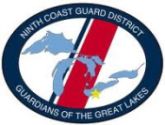SS Edmund Fitzgerald
(1958 - 1975)
Built as a conventional "straightdecker" at the Great Lakes Engineering Works, River Rouge, MI., for Northwestern Mutual Life Insurance Company, Milwaukee, WI., who entered into a 25 year contract with the Columbia Transportation Division the Oglebay Norton Company. Northwestern ordered their new ship to be built "within a foot of the maximum length allowed for passage through the Saint Lawrence Seaway," which was soon to be completed. Her completed measurements were 729(oa)x75x39 which made her the longest ship on the Great Lakes until the following year when the Canadian freighter Murray Bay was launched. Named after the President and Chairman of the Board of Northwestern Mutual Life Insurance, the Edmund Fitzgerald became popularly known by the nicknames of "Big Fitz", "Toledo Express" and "Pride of the American Flag".
On November 8th an intense storm was brewing over the Oklahoma Panhandle. The National Weather Service predicted the storm, traveling in a northeasterly direction and described as nothing more than a typical November storm, would pass south of Lake Superior on the 10th. The next day, as the Fitzgerald was taking on 26,535 tons of taconite pellets at Burlington Northern Railroad Dock No. 1 in Superior, Wisconsin, the storm shifted to a more northerly direction. The Fitzgerald departed Superior, WI., on her downbound journey at 2:15 p.m. in command of 62-year-old Captain Ernest M. McSorley. The NWS had updated their prediction and now placed the storm passing over Lake Superior east of Michipicoten Island by the early evening of the 10th.
The 767 foot SS Arthur M. Anderson departed Two Harbors, MN, at about 4:30 p.m., under command of Captain Jesse B. Cooper, bound for Gary, Indiana. The Anderson and Fitzgerald kept in radio contact as they traveled eastward along similar routes, but 10 - 20 miles apart with the Anderson in the lead. At 7 p.m. the NWS issued gale warnings for all of Lake Superior which was upgraded to storm warnings at about 2 a.m. on November 10th. Concerned over the deteriorating weather conditions both captains decided to turn northeasterly and continue in the lee of the Canadian shore; the faster Fitzgerald overtaking and passing the Anderson about an hour later. About 1:30 p.m. the Fitzgerald passed Michipicoten Island and by 2:45 p.m., when last actually seen by the Anderson, was about 16 miles ahead.
At 3:30 Fitzgerald contacted the Anderson and reported she had a fence rail down, was listing a bit and had both pumps going. A brief lull in the storm had ended and now, with seas running 12 - 16 feet, the Fitzgerald was checking down to allow the Anderson to close the gap between the two. Shortly afterwards a Coast Guard broadcast announced that the locks at Sault Ste. Marie had been closed and advised all ships to seek a safe anchorage. At about 4:10 p.m., just before passing east of of Caribou Island, both of the Fitzgerald's radars stopped working and she asked the Anderson to provide navigational assistance.
At about 6:55 p.m. two mountainous waves roared over the Anderson from astern, slamming into the rear of the pilothouse and driving her bow down into the sea before continuing their way down the lake towards the Fitzgerald.
At 7:10 p.m. the Anderson, now only 10 miles behind, informed the Fitzgerald of northbound traffic about nine miles ahead of her. When asked how she was doing the Fitzgerald's reply was "We are holding our own." Those were the last words ever heard from the Fitzgerald. Within the next 10 minutes she would disappear from the Anderson's radar. Captain Cooper stated that he called the Coast Guard in Sault Ste. Marie by radiotelephone at 7:39 p.m., 7:54 p.m., and 8:25 stating his concern about the Fitzgerald. At 9:03 p.m. he informed the Coast Guard that the Fitzgerald was missing.
The only Coast Guard rescue vessel in the vicinity at the time was the harbor tug Naugatuck. Because of her size and the severity of the storm she was ordered not to proceed beyond the entrance to Whitefish Bay. Naugatuck suffered a failure of a lube oil line and didn't get underway until 9 a.m. the next morning. Meanwhile the Coast Guard Cutter Woodrush was ordered out from Duluth, 300 miles away. The Coast Guard Station at Traverse City, Michigan, launched a HU-16 fixed wing search plane and two HH-52 helicopters, one equipped with a 3.8 million candlepower, Xenon arc searchlight. A massive search effort was now underway with the Coast Guard Station at Sault Ste. Marie making Urgent Broadcasts for assistance from any vessels in the area. Back into the storm went the SS Arthur M. Anderson and SS Henry Clay Ford. Joining in the search were the ARMCO, Reserve and William R. Roesch (sister ships of Fitzgerald); Roger Blough, Wilfred Sykes along with the Canadian vessels Frontenac, Joan O. McKellar, Murray Bay and James D. Three C-130 Hercules assisted with the air search. Only debris, including life rings, inflatable rafts, lifeboat No. 2 and part of lifeboat No. 1 were found.
A Navy Lockheed P-3 Orion, designed for anti-submarine warfare and equipped to detect magnetic anomalies, picked up a strong magnetic contact 17 miles north-northwest of Whitefish Point on November 14th. In the following days subesquent searches using side-scanning sonar showed two large objects lying close together, each approximately 300 feet long, which was believed to probably be the Fitzgerald. From May 20 to May 28, 1976, an underwater visual survey was conducted using the U.S. Navy CURV III system. The 895 color photographs and 43,225 feet of video tape showed the Fitzgerald lying in two pieces; her bow section upright and stern about 170 feet away in an inverted position with debris in between.
No one has ever determined exactly what caused the sinking of the Edmund Fitzgerald. Underwater surveys and sonar scans spanning the next 30 years have revealed no conclusive proof. Her sudden loss remains a mystery and a topic of debate. Her bell, long thought to be the soul of a ship, was recovered in 1995 at the request of the surviving family members and replaced with a replica bearing the names of the twenty-nine men who were lost. The original bell is displayed at the Great Lakes Shipwreck Museum at Whitefish Point, Michigan.
Wm. Rattigan, in writing the chapter about the Edmund Fitzgerald for his book "Great Lakes Shipwrecks & Survival," (1977) ends with this:
"Farewell, Edmund Fitzgerald. You will inherit the honor of having your shipwreck anniversary observed in company with theirs. And you will be remembered, all alone, among the giants of your day, because you were 'Big Fitz,' one of a kind, and there will never be another like you. Future shipwrecks will be measured by the date November 10, 1975."
- In Remembrance of Those Lost -
|
|





